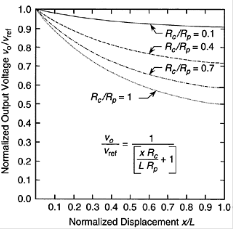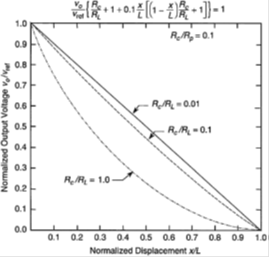SKEDSOFT
Optical Potentiometer
The optical potentiometer is a displacement sensor. A layer of photoresistive material is sandwiched between a layer of ordinary resistive material and a layer of conductive material. The layer of resistive material has a total resistance of RC, and it is uniform (i.e., it has a constant resistance per unit length). This corresponds to the coil resistance of a conventional potentiometer.
Numerically:
(1-a)Rc RLwhich is also the voltage across Rp, is given by[(1-a) RC RL] uo/RL. Note that a=x/L, is the fractional position of the light spot.




Behavior of the optical potentiometer at high load resistance.

The potentiometer has disadvantages such as loading problems (both mechanical and electrical), limited speed of operation, considerable time constants, wear, noise, and thermal effects. Many of these problems arise from the fact that it is a “contact” device where its slider has to be in intimate contact with the resistance element of the pot, and also has to be an integral part of the moving object whose displacements need to be measured.